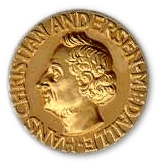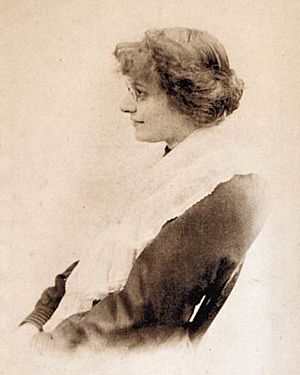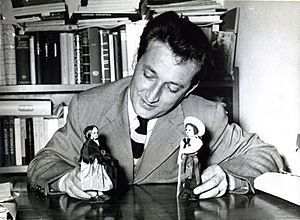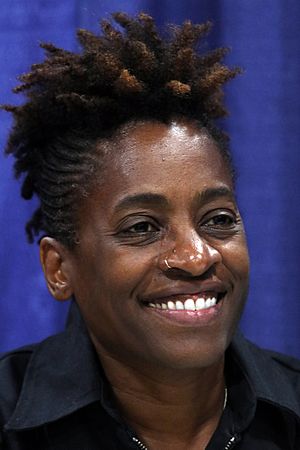Hans Christian Andersen Award facts for kids
Quick facts for kids Hans Christian Andersen Award |
|
|---|---|
 |
|
| Presented by | International Board on Books for Young People |
| First awarded | 1956 |
The Hans Christian Andersen Awards are very important literary awards. They are given by the International Board on Books for Young People (IBBY). These awards celebrate one living author and one living illustrator. They are honored for their "lasting contribution to children's literature". The award for writers started in 1956. The award for illustrators began in 1966. People sometimes call the writing award the "Nobel Prize for children's literature".
The awards are named after Hans Christian Andersen. He was a famous Danish author from the 1800s. He wrote many well-known fairy tales. Each winner gets a gold medal called the Hans Christian Andersen Medaille. This medal has a picture of Andersen's head on it. Winners also receive a special diploma. The medals are given out every two years at the IBBY Congress.
Contents
How are the winners chosen?
The winners of the Hans Christian Andersen Awards are picked by a special group called a jury. This jury is put together by IBBY's main committee. The person in charge of the jury, called the president, is chosen by IBBY's General Assembly.
At first, there were seven people on the jury. This number grew to eight, and then to ten in 2000. Two years later, the jury was split into two groups. Five members focused on authors, and the other five focused on illustrators. Jury members need to know a lot about children's books. They should also represent different parts of the world. It usually takes about six months to review all the candidates.
Jella Lepman was the first jury president. She led the jury for the first three awards, from 1956 to 1960. She stayed on the jury until she passed away in 1970. Other important presidents include Virginia Haviland and Ana Maria Machado.
The Selection Process
The rules for the award say that it is given every two years. It goes to an author and an illustrator who are still alive when they are nominated. Their work must be outstanding and have made a lasting impact on books for children and young people. The jury looks at all the books an author or illustrator has created. This award is meant to be international. It is not given to a specific country.
IBBY has many member countries around the world. Each country has its own local IBBY group. All member countries can suggest candidates for the awards. Some countries nominate the same person multiple times. Others choose a new candidate each time. To nominate someone, a special file is prepared. This file includes a list of their books and a short life story. It must also have five to ten books by the candidate. These books are sent to the jury members and IBBY's president. For the 2022 awards, there were 66 nominees from 33 different countries.
Award Winners for Writing



Award Winners for Illustration


| Year | Winner | Country | Award |
|---|---|---|---|
| 1966 | Alois Carigiet | Winner | |
| Jiří Trnka | Highly Commended | ||
| Brian Wildsmith | Highly Commended | ||
| 1968 | Jiří Trnka | Winner | |
| Ib Spang Olsen | Highly Commended | ||
| Brian Wildsmith | Highly Commended | ||
| Roger Duvoisin | Highly Commended | ||
| 1970 | Maurice Sendak | Winner | |
| Ib Spang Olsen | Highly Commended | ||
| Ota Daihachi | Highly Commended | ||
| Lidja Osterc | Highly Commended | ||
| 1972 | Ib Spang Olsen | Winner | |
| Elizabeth Cleaver | Highly Commended | ||
| Adolf Zábranský | Highly Commended | ||
| Janosch | Highly Commended | ||
| Petros Zambellis | Highly Commended | ||
| Björn Berg | Highly Commended | ||
| Felix Hoffmann | Highly Commended | ||
| 1974 | Farshid Mesghali | Winner | |
| Helga Aichinger | Highly Commended | ||
| Nicole Claveloux | Highly Commended | ||
| Charles Keeping | Highly Commended | ||
| 1976 | Tatjana Mawrina | Winner | |
| Fulla L'udovit | Highly Commended | ||
| Svend Otto S. | Highly Commended | ||
| 1978 | Svend Otto S. | Winner | |
| Leo & Diane Dillon | Highly Commended | ||
| 1980 | Suekichi Akaba | Winner | |
| Tomi Ungerer | Highly Commended | ||
| Etienne Delessert | Highly Commended | ||
| 1982 | Zbigniew Rychlicki | Winner | |
| 1984 | Mitsumasa Anno | Winner | |
| Helme Heine | Highly Commended | ||
| Raymond Briggs | Highly Commended | ||
| 1986 | Robert Ingpen | Winner | |
| Adolf Born | Highly Commended | ||
| 1988 | Dušan Kállay | Winner | |
| Yasuo Segawa | Highly Commended | ||
| 1990 | Lisbeth Zwerger | Winner | |
| 1992 | Květa Pacovská | Winner | |
| 1994 | Jörg Müller | Winner | |
| 1996 | Klaus Ensikat | Winner | |
| 1998 | Tomi Ungerer | Winner | |
| Binette Schroeder | Finalist | ||
| Dick Bruna | Finalist | ||
| Eidrigevicius, Stasys | Finalist | ||
| 2000 | Anthony Browne | Winner | |
| Rotraut Susanne Berner | Finalist | ||
| Boris Diodorov | Finalist | ||
| Maria Lucija Stupica | Finalist | ||
| 2002 | Quentin Blake | Winner | |
| Grégoire Solotareff | Finalist | ||
| Rotraut Susanne Berner | Finalist | ||
| Daihachi Ohta | Finalist | ||
| 2004 | Max Velthuijs | Winner | |
| Rotraut Susanne Berner | Finalist | ||
| Roberto Innocenti | Finalist | ||
| Javier Serrano | Finalist | ||
| Grégoire Solotareff | Finalist | ||
| 2006 | Wolf Erlbruch | Winner | |
| Lilian Brøgger | Finalist | ||
| Etienne Delessert | Finalist | ||
| Isol Misenta | Finalist | ||
| Grégoire Solotareff | Finalist | ||
| Klaas Verplancke | Finalist | ||
| 2008 | Roberto Innocenti | Winner | |
| Isol Misenta | Finalist | ||
| Svjetlan Junakóvic | Finalist | ||
| Adolf Born | Finalist | ||
| David Wiesner | Finalist | ||
| 2010 | Jutta Bauer | Winner | |
| Carll Cneut | Finalist | ||
| Etienne Delessert | Finalist | ||
| Svjetlan Junakovic | Finalist | ||
| Roger Mello | Finalist | ||
| 2012 | Peter Sís | Winner | |
| John Burningham | Finalist | ||
| Roger Mello | Finalist | ||
| Mohammad Ali Beniasadi | Finalist | ||
| Javier Zabala | Finalist | ||
| 2014 | Roger Mello | Winner | |
| Rotraut Susanne Berner | Finalist | ||
| John Burningham | Finalist | ||
| Eva, Lindström | Finalist | ||
| François Place | Finalist | ||
| Øyvind, Torseter | Finalist | ||
| 2016 | Rotraut Susanne Berner | Winner | |
| Alessandro Sanna | Finalist | ||
| Suzy Lee | Finalist | ||
| tMarit Törnqvist | Finalist | ||
| Pejman Rahimizadeh | Finalist | ||
| 2018 | Igor Oleynikov | Winner | |
| Pablo Bernasconi | Finalist | ||
| Linda Wolfsgruber | Finalist | ||
| Xiong Liang | Finalist | ||
| Iwona Chmielewska | Finalist | ||
| Albertine Zullo | Finalist | ||
| 2020 | Albertine Zullo | Winner | |
| Isabelle Arsenault | Finalist | ||
| Seizo Tashima | Finalist | ||
| Sylvia Weve | Finalist | ||
| Iwona Chmielewska | Finalist | ||
| Elena Odriozola | Finalist |
Winners by Country
Most winners of the Hans Christian Andersen Awards come from Europe and North America. The first winner from outside these regions was Farshid Mesghali from Iran in 1974. After winning the award, many authors and illustrators find their books become more popular. Their works are often translated into more languages. As of 2021, winners have come from 25 different countries.
The United States has had the most winners for writing (6). They also have the most total winners (7). Germany has won four illustration awards, which is the highest number for that category.
| Country | Illustration | Writing | No. of winners |
|---|---|---|---|
| 1 | 6 | 7 | |
| 4 | 2 | 6 | |
| 2 | 3 | 5 | |
| 2 | 3 | 5 | |
| 3 | 1 | 4 | |
| 3 | 1 | 4 | |
| 1 | 2 | 3 | |
| 2 | 1 | 3 | |
| 1 | 1 | 2 | |
| 1 | 1 | 2 | |
| 1 | 1 | 2 | |
| 1 | 1 | 2 | |
| 1 | 1 | 2 | |
| — | 2 | 2 | |
| — | 1 | 1 | |
| — | 1 | 1 | |
| 1 | — | 1 | |
| — | 1 | 1 | |
| — | 1 | 1 | |
| 1 | — | 1 | |
| — | 1 | 1 | |
| — | 1 | 1 | |
| — | 1 | 1 | |
| — | 1 | 1 | |
| 1 | — | 1 | |
| 1 | — | 1 | |
| 1 | — | 1 |
See also
 In Spanish: Premios Hans Christian Andersen para niños
In Spanish: Premios Hans Christian Andersen para niños

